Bulbs
Flower Basics
Flower Beds & Specialty Gardens
Flower Garden
Garden Furniture
Garden Gnomes
Garden Seeds
Garden Sheds
Garden Statues
Garden Tools & Supplies
Gardening Basics
Green & Organic
Groundcovers & Vines
Growing Annuals
Growing Basil
Growing Beans
Growing Berries
Growing Blueberries
Growing Cactus
Growing Corn
Growing Cotton
Growing Edibles
Growing Flowers
Growing Garlic
Growing Grapes
Growing Grass
Growing Herbs
Growing Jasmine
Growing Mint
Growing Mushrooms
Orchids
Growing Peanuts
Growing Perennials
Growing Plants
Growing Rosemary
Growing Roses
Growing Strawberries
Growing Sunflowers
Growing Thyme
Growing Tomatoes
Growing Tulips
Growing Vegetables
Herb Basics
Herb Garden
Indoor Growing
Landscaping Basics
Landscaping Patios
Landscaping Plants
Landscaping Shrubs
Landscaping Trees
Landscaping Walks & Pathways
Lawn Basics
Lawn Maintenance
Lawn Mowers
Lawn Ornaments
Lawn Planting
Lawn Tools
Outdoor Growing
Overall Landscape Planning
Pests, Weeds & Problems
Plant Basics
Rock Garden
Rose Garden
Shrubs
Soil
Specialty Gardens
Trees
Vegetable Garden
Yard Maintenance
How to Use Rockwool Cubes
How to Use Rockwool Cubes. First manufactured as a construction insulation, rockwool is a good growing medium for hydroponics because it holds water and retains air, making them available for good root growth. Made by melting a mixture of basaltic rock and sand and spinning it into fibers, the resulting material contains channels and spaces which...

First manufactured as a construction insulation, rockwool is a good growing medium for hydroponics because it holds water and retains air, making them available for good root growth. Made by melting a mixture of basaltic rock and sand and spinning it into fibers, the resulting material contains channels and spaces which give rockwool its desirable qualities. Different shapes and sizes of rockwool exist, from small cubes, larger blocks, still larger slabs and also loose granules of wool. Small sizes are used for starting seeds and cuttings, and larger sizes maintain rooted plants.
Preparing Soaking Water
The first step in using rockwool is to get it uniformly wet. Take care in handling the dry rockwool, because thin strands can break off and irritate your skin or breathing passages. Wear gloves, long sleeves and a mask, especially when handling loose forms. Because rockwool is alkaline, it might be necessary to adjust the pH of the water, especially if you live in an area with hard water, to 5.5 before you soak the rockwool. Test the water supply with a pH meter or pH paper to find out if the pH needs adjustment. Use a pH down adjuster or lemon juice to make the water more acid if necessary.
Starting Seeds
Before you work with rockwool, clean tools and working surfaces with a solution of 1 part household bleach mixed with 9 parts of water to prevent spreading pathogens. For germinating seeds, use little rockwool plugs or small rockwool cubes about 1 1/2 inch square. The cubes come either bare or wrapped in plastic, and for seeds you can use bare ones. For the plugs, mix some hydroponic plant food into a bucket of pH-adjusted water, making it no more than one-quarter strength. Small rockwool products such as macroplugs or miniblocks can just be dipped in this solution. Larger cubes should be soaked for 15 to 30 minutes in the pH-adjusted water, removed and flushed with the water that contains quarter-strength plant food. Shake out excess moisture, but don't squeeze the rockwool, since this destroys its physical structure and ability to hold water and air. Put one to two seeds into the hole in the top of the rockwool plug or cube, eventually snipping off the weaker seedling near the base.
Rooting Cuttings
To prevent excess water loss from unrooted cuttings, use rockwool propagation cubes that have plastic wrapped over four of the sides. Clean the tools and surfaces with the bleach solution. Add enough hydroponic plant food to pH-adjusted water to make the soaking solution one-third strength and soak the cubes for about 30 minutes. Cuttings dipped in rooting hormone go into the slit or hole in the top of the cube. Place cubes in a resealable plastic bag open 1/2 inch at the top. Check on cuttings after about a week. Test for rooting by gently tugging on the cutting. If it doesn't wiggle easily, open the bag to about 2 inches wide, increasing the width of the opening as the cutting forms new leaves and roots. The bag should be fully opened by the time the cutting is rooted.
Growing Seedlings and Cuttings
Once seedlings and cuttings have roots showing through the sides of the plugs or cubes, insert the original rockwool into a larger rockwool block or cube. Some cubes come with precut holes meant to receive the common sizes of rockwool propagation plugs and cubes, and you can just fit the rooted cube into the hole and insert the new cube into your hydroponic system. The roots grow into the new rockwool. An alternative is to put the rooted cube into a container appropriate for your hydroponic system and fill around it with soaked loose rockwool. For plastic-coated rockwool slabs, cut an X through the plastic the size of the rooted rockwool cube, fold back the plastic flaps, and put the container on top of the exposed rockwool.